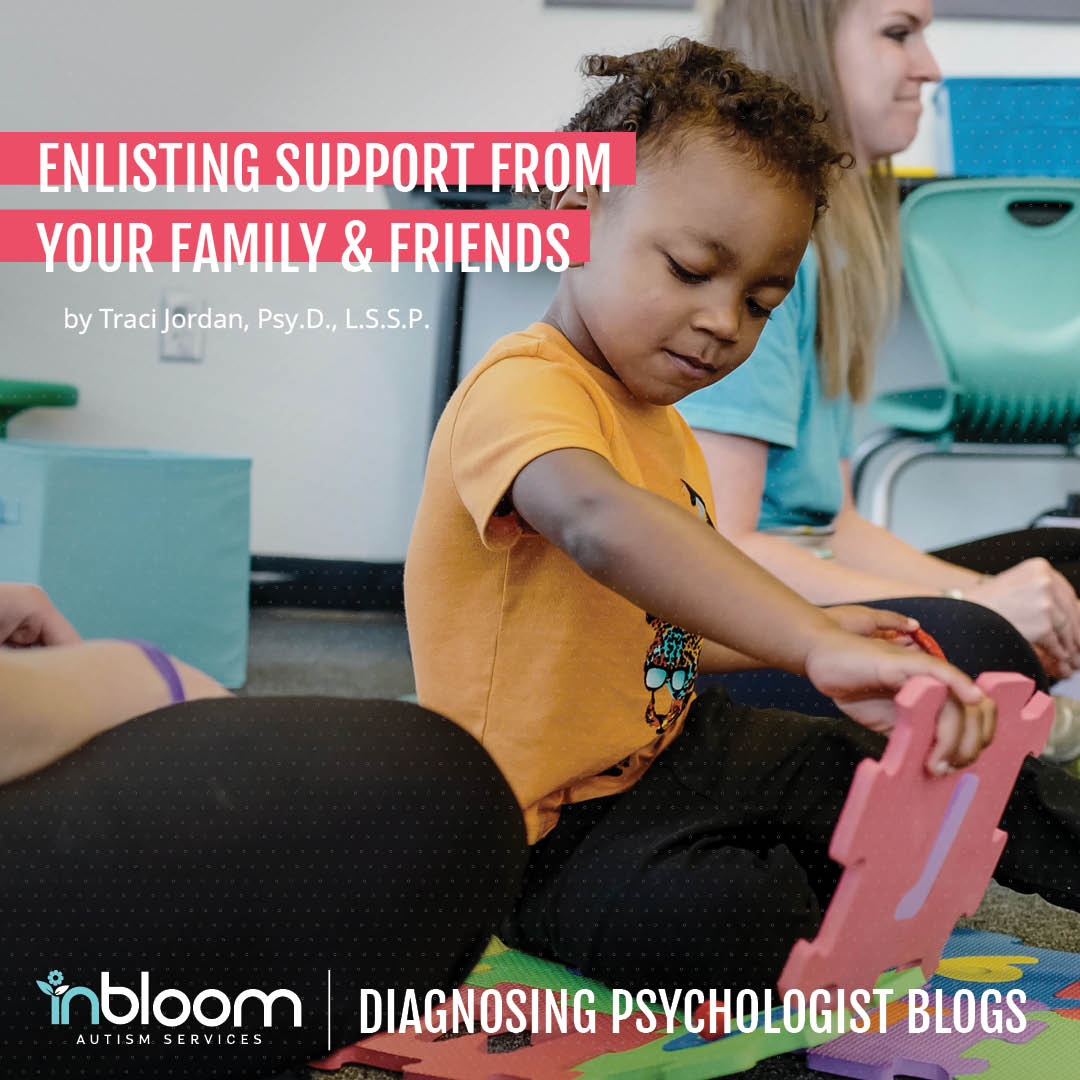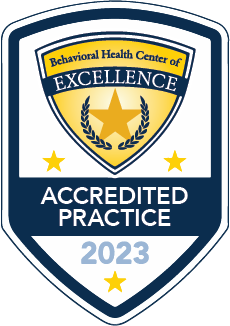ENLISTING SUPPORT FROM YOUR FAMILY & FRIENDS

Like most of us, you probably did not plan or prepare for your child’s autism diagnosis. You may have decided to seek an autism spectrum disorder evaluation for your child because you knew that they were struggling in fundamental ways. Maybe a family member has shared a concern about your child’s development. However, perhaps your child’s challenges were not readily apparent to everyone in your family. Autism, like many behavioral or learning disorders, is not always easy to recognize, it has been called an “invisible disability.” There is no blood work or definitive medical test. Maybe you started with a screening test at your pediatrician’s office, or perhaps you sought out a comprehensive evaluation with a psychologist.
What Happens After a Diagnosis?
Following an assessment and diagnosis, you faced an onslaught of choices and decisions, such as finding the right school match and therapies necessary to promote your child’s development. This complex process has yielded a wealth of information about your child. You learned more than you ever thought possible. You are mobilizing your resources and moving forward to help your child achieve their potential.
Now is the time to share valuable insights you’ve learned about your child with the people who mean the most to you. This journey will take all your resilience, and support from family can make the difference between feeling isolated and feeling valued as the head of your child’s team. In choosing how or whether to share information about your child’s diagnosis, it helps to remember this:
“Other things may change us, but we start and end with the family.”
– Anthony Brandt
Certain family members may have been with you since the first step of the journey. Some may want to help but are not sure how. Other family members may be more resistant. You may have heard these relatives say, “let them be a kid,” “wait and see,” or “don’t compare them with others.” What barriers will you face in educating your family about your child and how can you address them? Let’s take a look at a few common challenges:
…children on the spectrum may vary dramatically in their strengths and challenges.
1. Misunderstanding Autism Spectrum Disorder
When you decide to share your child’s diagnosis with a family member, they may have limited prior knowledge of autism. There are countless helpful articles/resources about autism on the internet, but they can be shuffled among tons of misinformation. Maybe your relative has seen a movie about autism or knows someone with autism, and they do not believe that the diagnosis fits your child. After all, there have been broad changes in how autism is defined within the medical profession. In recent years the medical field has moved toward a spectrum conceptualization, and children on the spectrum may vary dramatically in their strengths and challenges. Because we diagnose autism behaviorally, many of the symptoms are on a continuum based on severity and functionality. Sometimes, what we don’t understand is intimidating, and the first step is to acknowledge those feelings. You, too, may have experienced a range of emotions when first receiving the diagnosis, including sadness, anger, acceptance, relief, validation, and new joys.
2. Education Is Key
Not only can you validate your family member’s feelings, but you are also in the best position to educate family members and communicate what your child needs from them. You have learned so much about autism spectrum disorder since you first began to question, listen, and respond. When you share your child’s diagnosis with family members, be prepared to educate them on the basics:
- Autism spectrum disorder is a complex neurodevelopmental condition that starts in utero and is generally lifelong. Experts agree that there is a high genetic component to autism, although they have not isolated a single, specific gene or combination of genes.
- Autism spectrum disorder is associated with varying degrees of challenges in specific areas. However, every child on the spectrum differs significantly in the associated behaviors, the severity of the symptoms, and optimal interventions. For example, some children on the spectrum do not use words to communicate; others talk non-stop. Some children on the spectrum do not show social interest; others hug everyone in sight. All these children may share a common difficulty modifying their behavior to respond to social conventions and expectations.
- Autism spectrum disorder is not caused by environmental factors, although environmental factors certainly play a role in mediating behaviors and promoting strengths associated with autism spectrum disorder. Parenting does not cause autism. Children with autism are born to parents across ages, ethnic backgrounds, socio-cultural backgrounds, and religions.
Autism is a way of being in the world that may one day be an essential part of how your child identifies him or herself, but it may by no means be the only way.
3. Resistance to the Diagnosis
Another reason families fear labels is that they worry a diagnosis may become a label limiting your child’s educational and social opportunities. This concern may be more pronounced than if your child were dealing with a medical condition associated with a definitive medical test and treatment regimen, such as childhood diabetes.
4. Address the Fear of Labeling Head-On
Remind family members that people make judgments all the time; some may be accurate and others false. We can only focus on doing what in our hearts we know is right for our child. Point out that diagnosis is a shorthand way of conveying information; it does not define you or your child. Autism is a way of being in the world that may one day be an essential part of how your child identifies him or herself, but it may by no means be the only way. I had a foster child diagnosed with autism spectrum disorder when he was three years of age. In middle school, learning about the diagnosis helped him understand why he gravitated toward certain activities and avoided others. Talking about the diagnosis enabled him to embrace both his strengths and challenges and to appreciate his individuality. By the time he reached community college, it was still an essential aspect of how he saw himself in relation to others. However, there are now so many other facets of his identity, that is, how he sees himself in the world, including artistic aspirations and peer relationships, that his questions are less and less often centered around autism.
5. Point Out the Value of a Diagnosis
A diagnosis helps you understand and thus gives you a framework for responding to characteristic behaviors. For example, if you know that your child is prone to meltdowns when overtired, you avoid overscheduling daily activities. A diagnosis also enables you to take advantage of early intervention services. As Scott Allen, Psy.D., points out in a June 14, 2021, InBloom Autism Services blog, early diagnosis makes the most of your child’s neuroplasticity, which describes the process of stimulating or forming new neural pathways. Simply put, a young child’s brain may be more elastic and capable of making connections when learning than an adult’s brain. (Which you know if you have ever tried to learn a new language or instrument as an adult.) In addition, a diagnosis is a shorthand way of communicating information that allows you to work more effectively with educational and medical professionals. Perhaps most critically, a diagnosis opens the door to beneficial services that can make a world of difference in how your child learns to communicate, socialize, and achieve their potential.
A diagnosis also enables you to take advantage of early intervention services.
6. Put the Diagnosis Aside and Find Common Ground
ASD is a spectrum of disorders, and every child on the spectrum is an individual. Some children on the spectrum share a lot of the features; others may only share a few. For example, maybe your child’s challenge is maintaining social interaction, however, he or she is able to handle routine changes with ease. Focusing on your child’s specific behaviors and special strengths may enable you to reach a common understanding. ABA therapy can be an invaluable tool in helping children develop skills tailored to their unique strengths and challenges. In other words, put the diagnosis aside and talk about your child’s behaviors, both the gifts and the challenges.
For example, let your family know your child may not avoid eye contact because they are unfriendly; they may avoid eye contact because they are self-regulating or because direct eye contact is anxiety-provoking.
Explain to your family that your child is not having meltdowns because they are spoiled; they are most likely overstimulated and need a break. Point out that your child may have a fantastic fund of knowledge in areas that may be unfamiliar to others. (Although you occasionally remind the child that not everyone shares the same passion for these specific topics). For grandparents or people in your child’s life who are like grandparents, Autism Speaks offers a toolkit with terrific suggestions (e.g., grandparents participating in a visit with your child’s doctor or therapist). Other excellent references include the Official Autism 101 Manual, by Karen Simmons and A letter to Newly Diagnosed Parents and Families, by Scott Allen, Psy.D.
Parents are not generally prepared for a diagnosis of autism; it follows that most parents have not planned in advance how to tell loved ones about the diagnosis. Consider allowing the most important people in your life to participate in the unanticipated challenges and unexpected joys. You may be surprised to find out how family members pitch in when they understand how best to support you and your child. Your child’s needs may change as your child develops, but family, however you define family, will always be there.
Dr. Jordan holds a dual license in clinical and school psychology, and has assessment experience with a wide range of developmental, cognitive, psychological problems and challenges. She has a lifelong passion for child development and family systems, completing pre and postdoctoral training in child clinical and developmental pediatrics before opening a private practice focused on child assessment and treatment. She draws on her 30 years of experience in assessment and research methods to develop and teach a core graduate level class in psychodiagnostics through the Department of Educational Counseling of Texas A&M Corpus Christi. A mother and tireless advocate for children and diversity in her personal life; She is proud of serving as a foster parent for 10 years and as a board member for Nueces County Court Appointed Special Advocates (CASA). Yoga, family, friends, and pets keep her centered.
References
Allen, S. (2021, June 14). A letter to newly diagnosed parents and families. InBloom Autism
Services.
https://www.InBloomautism.com/post/a-letter-to-newly-diagnosed-parents-families.
Simmons, K. L., Grandin, T., Attwood, T., Rimland, B., Baker, J., Prizant, B. M. (2006). Official
Autism 101 Manual. (K. L. Simmons, Ed.). Exceptional Resources.
100 day kit for young children. Autism Speaks.
https://www.autismspeaks.org/tool-kit/100-day-kit-young-children


